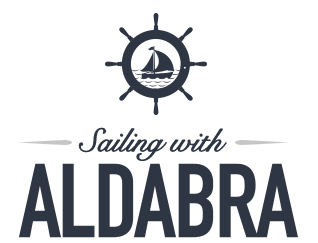On Thursday, November 9, we (along with several boats) pulled up the anchor at 9:00 a.m. and headed to the pass to leave North Minerva Reef. Outside the pass, we put up our mainsail with two reefs and then unfurled the jib. On port tack, we aimed for a waypoint just west of South Minerva Reef. We were on a very close reach at first but later the wind came more from behind and we sailed on a beam reach. Once we passed South Minerva Reef, we aimed for a waypoint that our router, John Martin, had provided, which took us slightly west of the rhumb line to Opua, New Zealand.

This shows our track as we leave Minerva Reef
Day One was eventful from a boat-issues standpoint. First, the pin on the autopilot RAM sheared off and we lost the ability to steer with the autopilot. Johno hand-steered for an hour while Pat went down into the lazarette and replaced the pin. Next, a familiar groan associated with the rudder stock resumed. We had not had problems with it for some time. We opened the port and lubricated the area associsted with the groan. When we did that, we noticed that the four bolts that hold the stock were loose and there was a lot of play. We tightened those bolts.
The seas were big and the wind was in the high teens or low twenties, so the boat was heeled over and bouncing around. Dinner flew off the stove and ended up on the floor but I served it anyway. Later that night, the line that held the anchor in place snapped, and the anchor was riding about four feet below the bow, trying to crash into the boat with every wave. We ran forward to secure it.
For the first twenty-four hours of the passage, we logged 161 nautical miles, which is very good for Aldabra. That’s an average of 6.7 nautical miles per hour. On Friday, conditions stayed very much the same, big seas and ample wind. I had been sleeping on the port-side settee while we were heeled over and I must have put too much pressure on the table because the legs came out of their bases. Everything on the table went flying to the floor and everything under the table shifted from the port side to the center of the boat. While Pat was on watch, Johno helped me put the table right and reorganize everything, and then I tied things more securely. Rather than risk dislodging the table again, I started sleeping very comfortably on the starboard settee.
The bilge pump was going on regularly for seconds at a time. We were taking on water, most likely at the bow. It was not because of the anchor mishap, fortunately. We were taking on water through the anchor windlass opening and perhaps from underneath the bow roller. None of it was threatening the safety of the boat but it would need to be investigated in New Zealand. Coincidently, other boats around us were reporting water coming into their boats. This kind of passage is going to expose issues that might go undetected in more benign conditions.
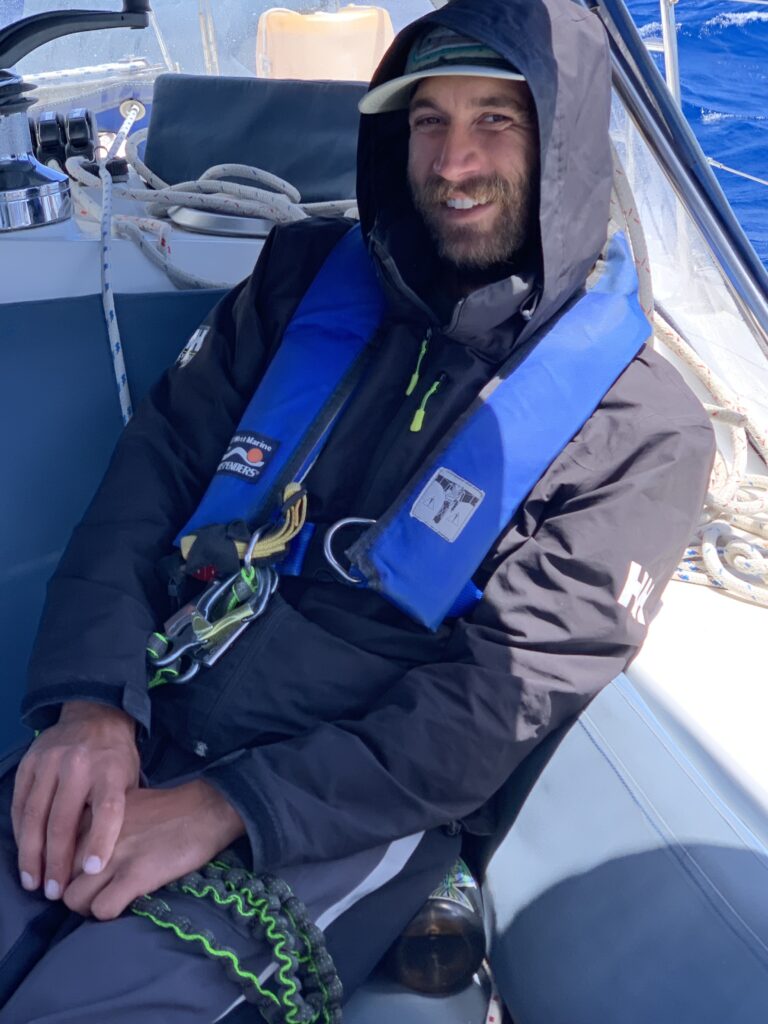
Johno is rarely seen all bundled up but the passage was getting cold
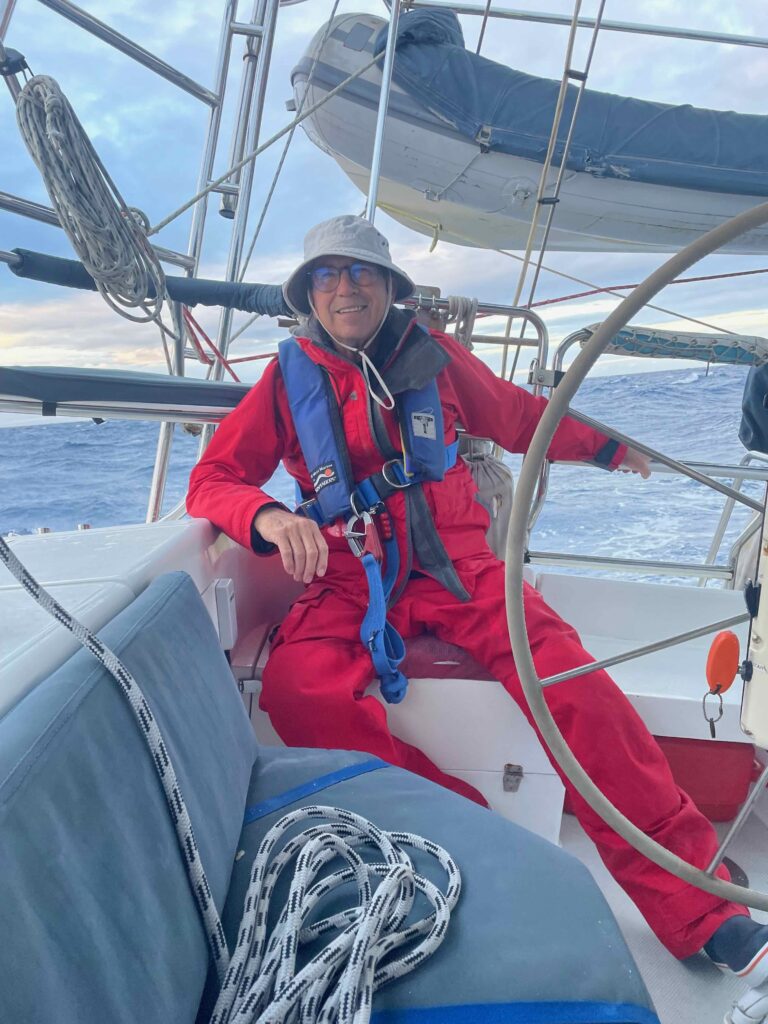
Pat in his foulies
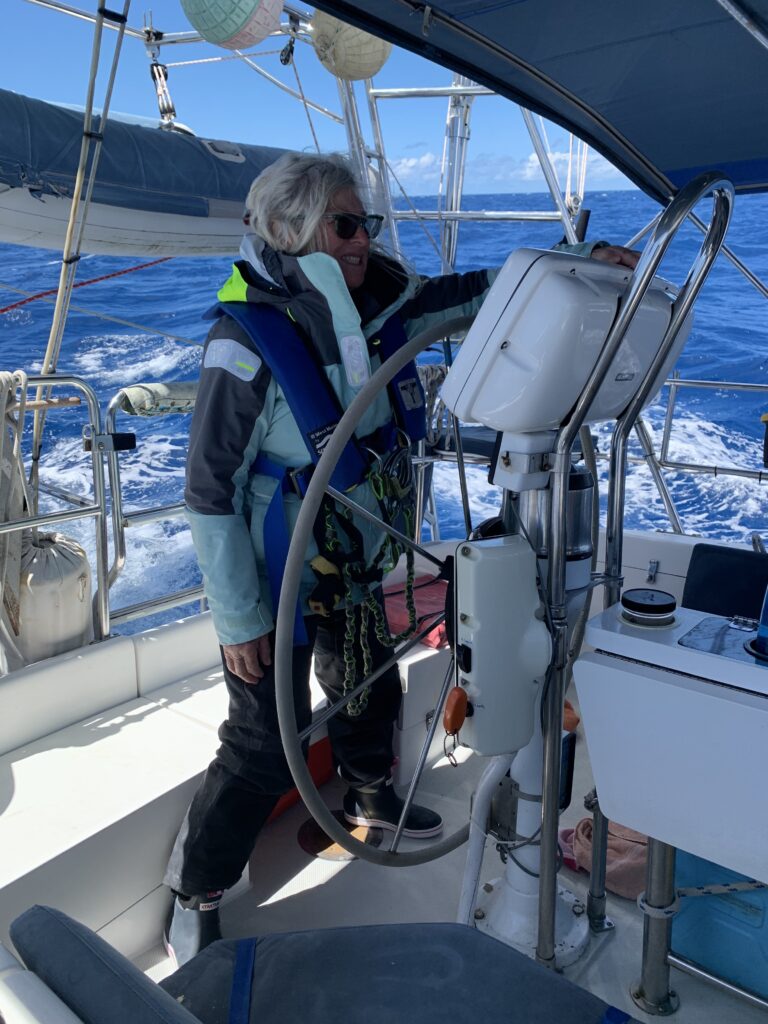
Bundled up
During the night on Friday, conditions intensified a bit. We had 25-30 knots of wind. It was wet and cold, with fish flying into the cockpit. Johno had to hand steer on his shift. Dinner ended up on the floor again but was still served. We also occasionally lost our GPS info for up to 20 minutes, which meant that we lost our position relative to the other boats on the water.

Johno’s shot of sunrise on Saturday morning
On Saturday morning, our mileage for the previous twenty-four hours was 159 nautical miles. It was a very windy day with very big waves. We continued sailing with a double-reefed main and a bit of jib pulled out. At one point, we were heeled over so much that the forward sink overflowed into the boat because water was being forced back into the boat from the thru hull.
Going into the evening, we were starting to sail more upwind. We slowed the boat down to manage for that wind angle and the big waves. At some point, we suspected that the anchor had come loose again. When we went to the bow to investigate, we noticed that the furling drum was bent forward because we had over-sheeted the jib. Afraid that we had damaged the forestay or the furling system, we furled the jib and sailed for the rest of the night with just the main. We also noticed that waves had broken two stanchions on the port side. We removed the full jerry cans of fuel from the stainless-steel rack on the port side, and secured them in the cockpit to take the stress off the broken railing.
On Sunday, November 12, the morning brought mellower conditions. We had sailed all night with no jib, but Johno had run the lines so that we could put up the storm jib. As soon as I woke up, we ran the spinnaker halyard up to the bow to back up the forestay. Then we hoisted the storm jib. The winds and the seas built during the day. We reached the intermediate waypoint that our router had provided, and started heading for a new waypoint that he thought would help us avoid an unfavorable current. It was slow going with the reefed main and the storm jib. During the previous twenty-four hours, our mileage was just 125 nautical miles.
On Monday, November 13, during my midnight to 4:00 a.m. shift, the winds were subsiding. I had to run the motor to keep us on our line to the waypoint and to keep us above 4 knots of boat speed. I would keep the motor in gear during light winds and put it into neutral when squalls would pass through and bring stronger winds. Our mileage for the previous twenty-four hours was 119 nautical miles. Later in the morning, we ran a new furling line for the regular jib and started using it instead of the storm jib. That helped our boat speed as we sailed all morning. In the afternoon, we motor sailed for several hours.
Sunset out on the water

Johno took this sunrise shot on Tuesday morning
Tuesday started out very mellow with lighter seas and winds. Then the winds and seas started to build. We started sailing on just the reefed main and no jib. It was another 119 mile day. The wind stayed strong all day and into the night. Eventually we tacked over to starboard. Slowly, as we got closer to New Zealand, the seas started to flatten a bit. We turned the motor on before midnight to stay on course.
On Wednesday, November 15, we got to the entrance of the bay at 3:30 a.m. After being in remote locations for so long, it was interesting to listen to all the radio traffic. There was one boat chiding a tanker because it failed to respond to a radio request when they were on a collision course. And then the maritime authorities of New Zealand managed a rescue, which kept me engaged for more than an hour. Johno took the helm at 4:00 a.m. and we continued through the harbor to Opua.
It took us about an hour and a half to get to the quarantine dock. We didn’t quite know where we were going so we ended up on the quarantine dock for superyachts. But the Customs and Biosecurity officials were fine with seeing us there. It took the better part of the day to check in, but we had a good experience with both sets of officials. Later that afternoon, after we were checked in, we took the boat into the marina, and Steve and Sharon from Szel helped us with our docklines. That night, we went to the Opua Cruising Club for drinks and dinner and met up with boat crews we had made the passage with as well as crews we hadn’t seen for some time. It was great fun.
The marina in Opua is very nice. On Thursday morning, Pat and I took advantage of their exceptional laundry facilities and did several loads of laundry, while Johno went for a hike. That evening, we returned to the Opua Cruising Club for another fun night of socializing with all the friends we had made over the last several weeks.
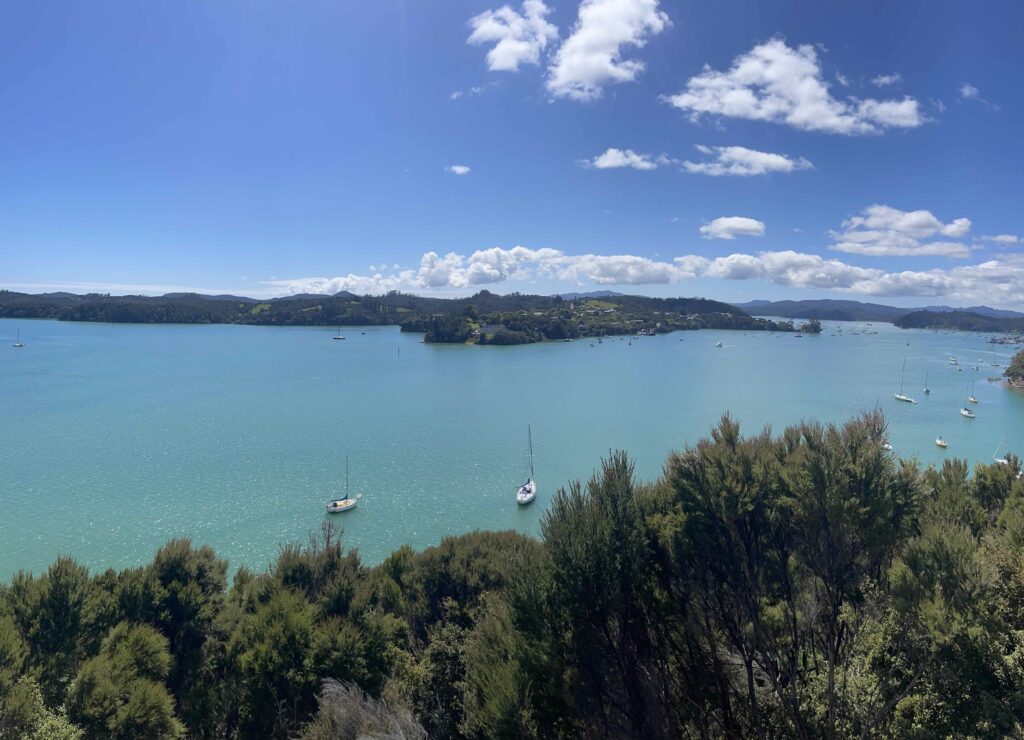
Johno took this on his hike in Opua
The next day, on Friday morning, we checked out of the marina and cast off our dock lines at 9:00 a.m. We motored out of the bay and then sailed downwind, with winds in the high teens, to the entrance of the bay that leads to Whangarei.

Sailing through the Bay of Islands
The scenery on the way south was gorgeous and we had a lovely sail, anchoring in Urquhart Bay just before dark, along with the sailboat Taku. We had a late dinner and slept well before pulling up anchor at 9:00 a.m. on Saturday to motor up the river to the marina in Whangarei. Midnight Breeze was right behind us and we went through the drawbridge together.
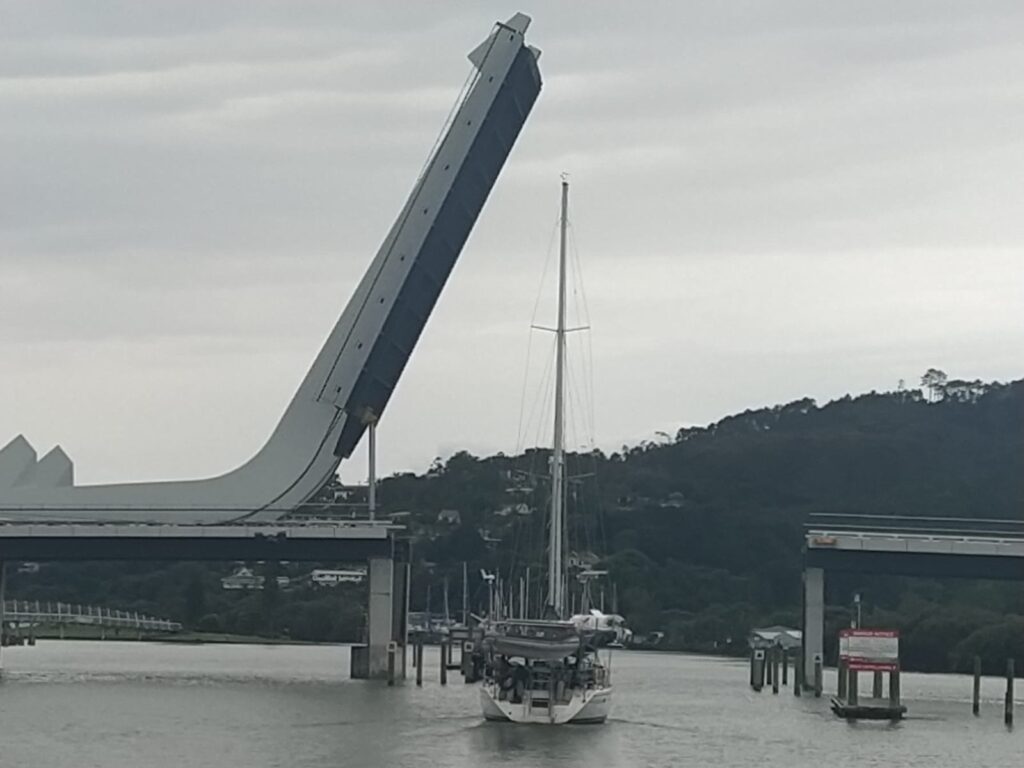
Aldabra going through the bridge opening on the way to the marina in Whangarei
After getting settled into our slip in Marina Whangarei, we took showers and then joined some other cruisers at The Judge restaurant in town. We had a very nice visit with Dale and Katrina on Womble, who we hadn’t seen since we were in the Tuamotus in August of 2022.
From Sunday until Wednesday morning, we worked on the boat during the day, getting ready to leave it for a few weeks. During the evenings we visited with cruiser friends, including Dale and Katrina on Womble, Richard and Caroline on Midnight Breeze and Jamie on Szel. Right before we left, we moved to another slip.
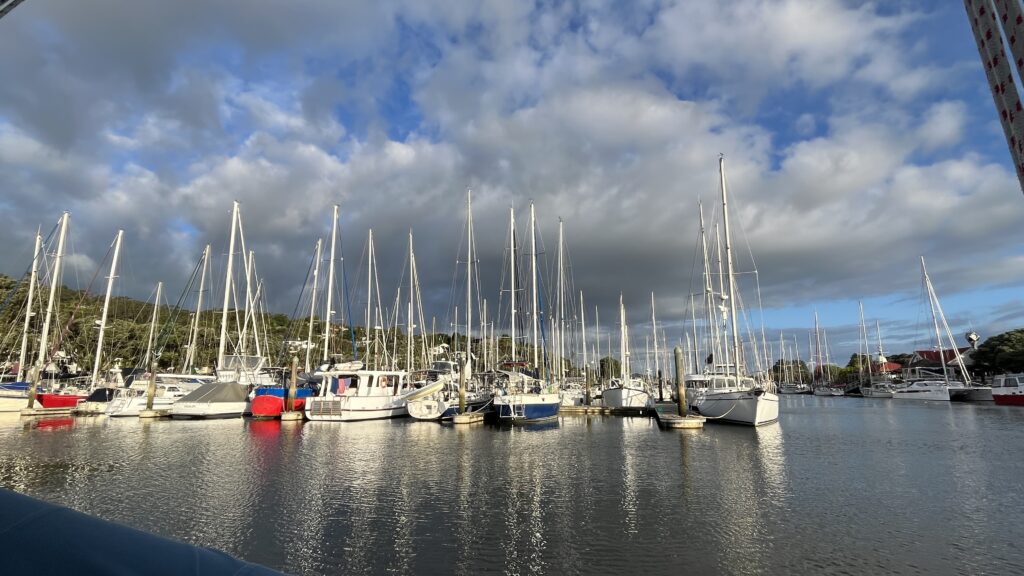
Our marina in New Zealand
Then, with our boat projects completed, we hopped on a bus for Auckland. Once there, we took a cab to a hotel at the airport, spent the night and caught our planes back to the States on Thursday afternoon. We arrived early on Thursday morning, just in time for Thanksgiving festivities.
